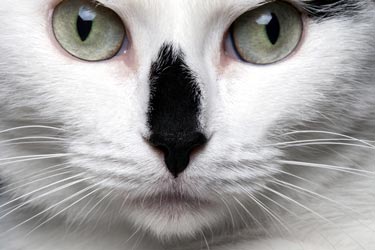Corneal Ulcers in Cats

The cornea is the transparent outer layer of the eyeball. It's made up of three layers of cells. If the outermost layer is penetrated, it is called a corneal abrasion. A deeper wound in the cornea is called a corneal ulcer.
Causes and Signs of Feline Corneal Ulcers
The most common cause of corneal ulcers in cats is trauma. The kitty might rub her eye on a rough surface and injure it, it might be scratched by the claw of another cat, or a thorn or other foreign object might poke the eye.
Foreign debris getting into the eye can also cause corneal ulcers, and so can chemicals like shampoo that make their way into the eye and don't get rinsed out.
Corneal ulcers may also be secondary to other eye conditions in cats. For instance, a severe eye infection can cause damage and eventual ulceration to the cornea.
The signs of corneal ulcers in cats include:
- Squinting of the affected eye
- Discharge from the eye
- Pawing at the eye or rubbing it on the carpet or furniture
Corneal ulcers are painful. Some cats will hide or refuse to eat when they have one.
Diagnosis of Corneal Ulcers in Cats
Sometimes severe abrasions of the cornea can be easily seen. Most of the time, however, a special dye called fluorescein stain needs to be applied to the cornea, which sticks to the abrasion and causes it to be clearly visible as a greenish area on the surface of the eye.
Treatment of Feline Corneal Ulcers
Superficial corneal abrasions will heal on their own in a few days if the cat isn't allowed to further traumatize the area by rubbing at it and bacteria is prevented from taking hold in the injured area. Some cats must wear an E-collar to accomplish this, and eye drops or ointment are applied a few times a day. The doctor will recheck the eye in a few days to verify that it has healed. Atropine drops are sometimes used to help control the pain of the corneal ulcer while it is healing.
For deeper or more complicated corneal ulcers, additional treatment might be necessary. Surgery is sometimes required to remove dead cells from around the ulcer and promote blood flow and healing. The cat's third eyelid is sometimes sutured closed over the cornea to provide protection.
Drops and ointments containing corticosteroid are counter-indicated and should never be used when a corneal abrasion or ulcer is present. Never use eye medication you have at home on your cat without your veterinarian's input.
You May Also Like These Articles:
How To Know When Your Cat Is Sick
Why Do Some Cats Have Two Different Colored Eyes?
Eye Infections in Young Kittens
First Aid for Eye Injuries in Cats
Notice: Ask-a-Vet is an affiliated service for those who wish to speak with a veterinary professional about their pet's specific condition. Initially, a bot will ask questions to determine the general nature of your concern. Then, you will be transferred to a human. There is a charge for the service if you choose to connect to a veterinarian. Ask-a-Vet is not manned by the staff or owners of CatHealth.com, and the advice given should not delay or replace a visit to your veterinarian.




